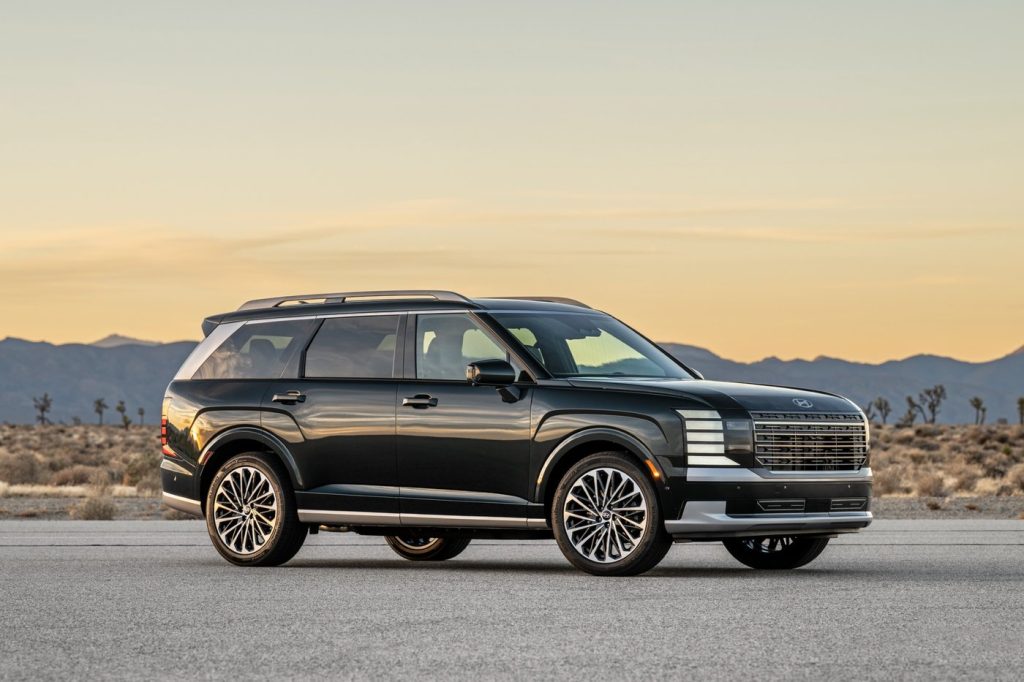Top Stories
Hyundai Palisade Revamped for 2026, Kia Telluride Holds Steady

The automotive landscape is shifting as the 2026 Hyundai Palisade makes its debut, showcasing significant upgrades that may influence potential buyers of three-row SUVs. Designed to refine an already acclaimed model, the second-generation Palisade features new styling, enhanced engines, and advanced technology. In contrast, the Kia Telluride remains unchanged for now, with its anticipated redesign yet to be officially detailed. This raises the question for consumers: should one opt for the newly updated Palisade, the current Telluride, or hold out for future developments?
Price and Value Comparison
Pricing is often a decisive factor in vehicle selection. The 2026 Palisade starts at $41,035, including destination fees, while the 2025 Telluride has a more accessible starting price of $37,885. Both SUVs come equipped with standard features like eight-passenger seating, LED headlights, and a 12.3-inch touchscreen that supports Apple CarPlay and Android Auto smartphone integration.
While the Telluride offers synthetic leather upholstery as standard, enhancing its premium appeal, the Palisade justifies its higher price with additional features such as wireless connectivity for smartphone integration, front and rear parking sensors, and automatic braking when reversing. On the higher end, a fully loaded Telluride SX-Prestige costs $52,885, compared to the Palisade Calligraphy at $56,160. The Palisade provides unique offerings like a massaging driver’s seat and integrated dashcams. In this category, both models present strong value propositions.
Performance and Efficiency
The performance capabilities of these two SUVs also merit examination. The 2026 Palisade introduces two new engines: a standard 287-horsepower V6, which achieves an estimated 21 mpg in combined driving, and a turbocharged hybrid variant producing 258 horsepower, though fuel economy estimates for the hybrid remain forthcoming. Despite these enhancements, the new base V6 is heavier, resulting in slower acceleration—taking 8.8 seconds to reach 60 mph, making it less competitive in its class.
Conversely, the Telluride features a 291-horsepower V6 that reaches 60 mph in just 7.5 seconds, with a combined fuel economy of up to 22 mpg. As the Palisade Hybrid enters the market, it will be interesting to see how these powertrains compare. Currently, buyers must weigh the Telluride’s superior acceleration against the Palisade’s potential for better fuel efficiency.
Comfort and Cargo Capacity
Comfort remains a pivotal aspect for families choosing a three-row SUV. The Palisade excels in providing a serene and comfortable ride, effortlessly absorbing bumps and providing ample visibility for drivers. Its interior space boasts generous headroom and legroom across both rear rows, enhancing passenger comfort.
The Telluride also features a plush and accommodating interior, yet the Palisade’s enhancements place it just ahead in this metric. Cargo capacity is another essential consideration; the Palisade offers 19.1 cubic feet behind the third row and 86.7 cubic feet with all rear seats folded down. Although the Telluride lists slightly more cargo space, the difference is negligible in practical usage.
In summary, the newly redesigned Palisade refines an already strong contender in the three-row SUV category. While it currently boasts a number of advantages, the upcoming redesign of the Telluride may soon level the playing field. As buyers consider their options, both models offer compelling features that cater to family needs, making this comparison crucial for informed decision-making.
This article was provided to The Associated Press by the automotive website Edmunds. Dan Frio contributed to this report.
-

 Education3 months ago
Education3 months agoBrandon University’s Failed $5 Million Project Sparks Oversight Review
-

 Science4 months ago
Science4 months agoMicrosoft Confirms U.S. Law Overrules Canadian Data Sovereignty
-

 Lifestyle3 months ago
Lifestyle3 months agoWinnipeg Celebrates Culinary Creativity During Le Burger Week 2025
-

 Health4 months ago
Health4 months agoMontreal’s Groupe Marcelle Leads Canadian Cosmetic Industry Growth
-

 Science4 months ago
Science4 months agoTech Innovator Amandipp Singh Transforms Hiring for Disabled
-

 Technology4 months ago
Technology4 months agoDragon Ball: Sparking! Zero Launching on Switch and Switch 2 This November
-

 Education4 months ago
Education4 months agoRed River College Launches New Programs to Address Industry Needs
-

 Business3 months ago
Business3 months agoRocket Lab Reports Strong Q2 2025 Revenue Growth and Future Plans
-

 Technology4 months ago
Technology4 months agoGoogle Pixel 10 Pro Fold Specs Unveiled Ahead of Launch
-

 Technology2 months ago
Technology2 months agoDiscord Faces Serious Security Breach Affecting Millions
-

 Education4 months ago
Education4 months agoAlberta Teachers’ Strike: Potential Impacts on Students and Families
-

 Education4 months ago
Education4 months agoNew SĆIȺNEW̱ SṮEȽIṮḴEȽ Elementary Opens in Langford for 2025/2026 Year
-

 Science4 months ago
Science4 months agoChina’s Wukong Spacesuit Sets New Standard for AI in Space
-

 Business4 months ago
Business4 months agoBNA Brewing to Open New Bowling Alley in Downtown Penticton
-

 Business4 months ago
Business4 months agoNew Estimates Reveal ChatGPT-5 Energy Use Could Soar
-

 Technology4 months ago
Technology4 months agoWorld of Warcraft Players Buzz Over 19-Quest Bee Challenge
-

 Business4 months ago
Business4 months agoDawson City Residents Rally Around Buy Canadian Movement
-

 Technology2 months ago
Technology2 months agoHuawei MatePad 12X Redefines Tablet Experience for Professionals
-

 Technology4 months ago
Technology4 months agoFuture Entertainment Launches DDoD with Gameplay Trailer Showcase
-

 Top Stories3 months ago
Top Stories3 months agoBlue Jays Shift José Berríos to Bullpen Ahead of Playoffs
-

 Technology4 months ago
Technology4 months agoGlobal Launch of Ragnarok M: Classic Set for September 3, 2025
-

 Technology4 months ago
Technology4 months agoInnovative 140W GaN Travel Adapter Combines Power and Convenience
-

 Science4 months ago
Science4 months agoXi Labs Innovates with New AI Operating System Set for 2025 Launch
-

 Technology4 months ago
Technology4 months agoNew IDR01 Smart Ring Offers Advanced Sports Tracking for $169










